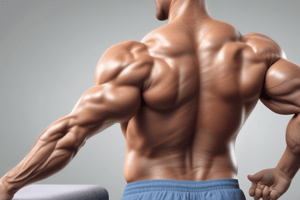Podcast
Questions and Answers
What is defined as variable tensions caused by changing velocities and joint angles during free weight lifting?
What is defined as variable tensions caused by changing velocities and joint angles during free weight lifting?
- Auxotonic (correct)
- Static
- Isometric
- Isotonic
Which muscle action is characterized by maximal contraction at a constant velocity?
Which muscle action is characterized by maximal contraction at a constant velocity?
- Eccentric
- Isometric
- Isokinetic (correct)
- Static
What does muscular endurance specifically refer to?
What does muscular endurance specifically refer to?
- Ability to exert submaximal force over time (correct)
- Speed of muscle contraction
- Force exerted at maximal effort
- Resistance against gravity
Which muscle action best describes a braking force that resists gravity?
Which muscle action best describes a braking force that resists gravity?
When the muscle force exceeds the resistance, which muscle action occurs?
When the muscle force exceeds the resistance, which muscle action occurs?
What can hand grip dynamometers assess?
What can hand grip dynamometers assess?
What is the primary function of variable resistance machines?
What is the primary function of variable resistance machines?
The V-sit test primarily assesses which type of muscular endurance?
The V-sit test primarily assesses which type of muscular endurance?
Flashcards are hidden until you start studying
Study Notes
Muscle Actions Overview
- Auxotonic actions involve variable tensions from changing velocities and joint angles, commonly associated with lifting free weights.
- Isokinetic contraction occurs at a constant velocity throughout the full range of motion.
- Muscular endurance refers to the ability to exert submaximal force over prolonged periods.
Eccentric and Concentric Actions
- Eccentric muscle action functions as a braking force, resisting gravity or decelerating fast-moving body segments.
- Concentric muscle action takes place when the muscle force exceeds external resistance.
Strength Assessments
- Hand grip dynamometers assess static muscular strength and static muscular endurance.
- Variable resistance machines aim to eliminate sticking points in lifts using mechanisms like cams or pulleys.
Testing Methods
- The V-sit test evaluates isometric muscular endurance of trunk flexors.
- Free weights are suggested for determining dynamic one-repetition maximum (1RM).
Strength Measurement Insights
- Dynamic strength measurement is not limited to the weakest point in a joint's range of motion with free weights.
- Trunk curl tests do not strongly correlate with abdominal strength, indicating the need for diverse assessment methods.
Studying That Suits You
Use AI to generate personalized quizzes and flashcards to suit your learning preferences.



